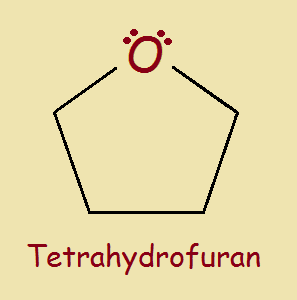 Tetrahydrofuran (C4H8O) is a heterocyclic hydrocarbon. One of the carbon atoms of a cyclopentane ring (along with its two hydrogen atoms) is replaced by an atom of oxygen.
Tetrahydrofuran (C4H8O) is a heterocyclic hydrocarbon. One of the carbon atoms of a cyclopentane ring (along with its two hydrogen atoms) is replaced by an atom of oxygen.
THF is an ether. It’s frequently used for its solvent properties. In certain organometallic reactions, tetrahydrofuran replaces all or part of the standard solvent diethyl ether, (C2H5-O-C2H5), written in chemists’ shorthand Et-O-Et.
Tetrahydrofuran Vs. Diethyl Ether
Although THF is essentially diethyl ether gone cyclic, its physical properties differ somewhat.
A prime example of that relates to hydrogen bonding. Although both molecules possess an electron-rich oxygen atom, in THF, the oxygen is openly exposed. The ring can twist, but that’s about it.

The hydrocarbon portions of ethyl ether¹ have much greater freedom of motion. They can sweep around, making hydrogen bonding easier to make and break. See the illustrations.
Due to this, ethyl ether exhibits a lower polarity than tetrahydrofuran. According to the principle of “like dissolves like”, low polarity substances favor ethyl ether as solvent over THF, whereas more polar substances favor THF.
Which/When to Use?
Note the two images that illustrate methylmagnesium coordination complexes. In addition to the freedom of motion of the hydrogen atoms of ethyl ether, there are other factors to take into consideration.

These include boiling point (Et-O-Et 35o C, THF 67o C), flammability and water solubility. Ethyl ether has an historically hazardous “reputation”, though with careful forethought, it can be handled safely in the laboratory.
Combinations of these two solvents may be the logical choice, varying percentages of each as suited to the reaction being considered.
1 We will follow the common practice of shortening the name “diethyl ether” to ethyl ether.
2 A halide is an organic compound with a covalent bonded halogen atom, such as chlorine or bromine iodine or fluorine.
Note: You might also enjoy How to Glue Teflon
References:
- Science Direct: Organic Chemistry (2nd Ed., 2018) by Ouellette & Rawn
- University of Manitoba: A Guide to Solvents and Reagents in Introductory Organic Chemistry
← Back to Classic Science
← Home

So basically, the THF is Et-O-Et minus 2 hydrogen atoms? Is that what “forces” it to take up a ring form?
Not to overstate things, pretty much.